10 Valuable tips to create and present effective presentations to senior executives

Stepping into a room full of senior executives can feel like entering the lion's den. The stakes are high, and every moment counts. This is your moment—a chance to influence the decision-makers at the very top. It's not just about being heard, but about making an impact.
"When you try to talk to everyone, you end up talking to no one." - Meredith Hill
This insight is crucial when you’re presenting to a room where every attendee has the power to change the course of your project or career. Crafting your presentation for this C-suite audience isn't about using big words or complex graphics; it's about connecting, being clear, and getting straight to the point.
Before you step up to present, let me share ten powerful tips with you. These aren’t just tricks of the trade; they’re your toolkit for turning nervous energy into a standout performance and detailed data into decisive actions. So, get ready—because we’re about to elevate your skills in presenting to executives from just okay to absolutely stellar.
What does C-suite mean?
You've heard the term "C-suite" thrown around, but what does it really mean? The "C" in C-suite stands for "Chief," referring to the top executives in a company. These are the decision-makers who steer the ship—whether it's the Chief Executive Officer (CEO) who calls the shots, the Chief Financial Officer (CFO) who manages the money, or the Chief Operating Officer (COO) who keeps everything running smoothly.
These leaders occupy the highest ranks in an organization and play crucial roles in shaping its future. Each "Chief" has a critical area of focus, but all share the responsibility of setting strategy, making pivotal decisions, and ensuring the company’s long-term success. Understanding who sits in the C-suite can give you valuable insights into how a business operates and what drives its leaders. This knowledge is not just useful; it's essential for anyone looking to make a meaningful impact in the corporate world.

Why is effectively presenting to senior executives important?
Why take the time to prepare specifically for executive presentations? When you're presenting to seniors, you're not just sharing information; you're potentially influencing the future of the entire company. These presentations are your opportunity to stand out and make your voice heard at the highest level.
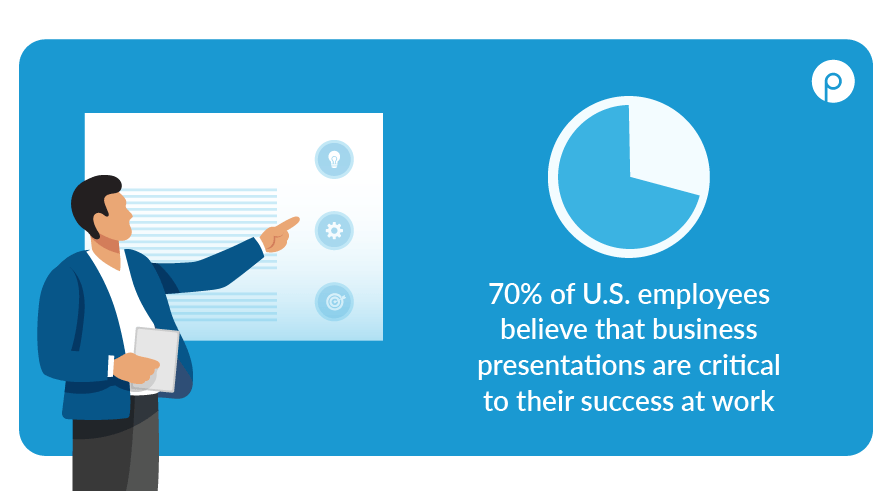
Executive presentations are crucial because they allow you to directly communicate your ideas and insights to the people who have the power to make big decisions. Whether it’s getting approval for a new project, influencing company strategy, or securing funding, your presentation can directly impact these outcomes.
Moreover, these presentations help build your reputation within the company. A strong, well-delivered presentation can mark you as a thoughtful leader and a go-to person for solving important issues. This visibility can lead to more opportunities, greater responsibilities, and career advancement. In short, mastering the art of presenting to executives can open many doors.
What makes executive presentations so challenging?
When you present to senior executives, it's not just about giving information — it's about making a real impact. This situation can be very stressful and is full of challenges, even for people who are used to speaking in public. The first step to doing well is to understand these challenges. In this part, we will look at the main difficulties the presenters may face.
The leaders may have impatient mindset
Executives are incredibly busy, often managing vast areas of a business. Their time is their most valuable asset so they may be impatient. A survey by The Harvard Business Review highlighted that CEOs spend nearly 72% of their work time in meetings. This means when you present, you need to convey your message succinctly and effectively within a tight timeframe—often you'll have just minutes to make your case.
Frequent interruptions
Executives are not just passive listeners; they are active participants who may interrupt with questions or comments. As Jeff Bezos reportedly employs the "two-pizza rule" (meetings should be small enough that two pizzas can feed everyone), it underscores the need for small, interactive sessions where interruptions are likely. Being prepared to handle these smoothly, without losing your train of thought or control of the presentation, is vital.
Pre-existing strong opinions
It's common for executives to have well-established views, which they may vigorously defend during presentations. This was famously illustrated by Steve Jobs, who was known to rigorously challenge ideas to ensure only the most robust concepts were executed. When presenting, anticipate these strong opinions and prepare clear, evidence-based responses. This approach can transform potential confrontations into opportunities for meaningful dialogue and collaboration, ultimately enhancing the impact of your presentation.
High-stakes
The decisions these leaders or stakeholders make based on what you demonstrate can significantly influence the company's direction and success.
"You only have to do a very few things right in your life so long as you don’t do too many things wrong." - Warren Buffet
Which means this pressure makes delivering a persuasive and factual presentation crucial because a single decision can result in millions of dollars gained or lost.
Overcome diverse preferences
Each executive has a unique style and mindset for receiving information. While one may prefer detailed financial breakdowns, another might favor strategic outlines with a strong narrative. Understanding and adapting to these preferences requires a presenter to be versatile and responsive. For instance, Steve Jobs was known for his dislike of lengthy presentations and preferred bold, visually impactful slides that complemented a narrative storytelling approach.
Keeping high engagement from start to finish
Capturing and holding the attention of busy executives throughout your presentation is a challenge in itself. They are frequently pulled in multiple directions and may be mentally preparing for other commitments even as they sit through your presentation. Ensuring your recommendation is engaging, relevant, and dynamically delivered is key to keeping their focus on your message.
10 tips to improve your presentation skills to engage senior leaders and executives?
Crafting an engaging presentation for senior leaders is an art that can significantly shape your career. Below are ten finely honed tips and strategies designed to improve your presentation skills to not only capture attention but also deeply resonate with top-position decision-makers.
1. Quickly frame the topic
In the first 30 seconds, clearly explain what you will discuss and how it aligns with other priorities that the leaders at top position may have. The executive suite is a busy place filled with many competing interests. By quickly framing the topic, you help executives transition into the right mindset, focusing their attention where you need it most.
As Jeff Weiner, former CEO of LinkedIn, advises, 'Clear, concise communication is a powerful leadership tool.' Use your opening lines to provide a compelling overview that hooks your audience from the get-go.
2. Set expectations for the meeting
Begin by clearly outlining the presentation time and what topics will be covered during that time.
- Value their time: Always respect the executives' schedules. Avoid the common pitfall of extending the meeting beyond the expected timeframe. A meeting that runs longer than anticipated can disrupt their day and may lead to a negative reception of your message.
- Invite contributions: Early in the meeting, graciously ask if there are any topics the executives would like to add to the agenda. This not only shows respect for their expertise and role but also helps ensure that their current priorities are addressed.
- Address immediate concerns: If there are pressing issues that might overshadow your scheduled topics, tackle these first. This approach clears the way for focused attention on the main agenda and demonstrates your sensitivity to their immediate concerns.
3. Use an inductive approach
Start your presentation with the key findings or conclusions. This reverse structure grabs attention by addressing the 'why' before the 'how.'
- Lead with the end: By presenting conclusions at the beginning, you cater to the executive preference for efficiency and relevance, ensuring your key messages resonate from the start.
- Highlight relevance: Immediately get to the point and explain how your conclusions align with the company’s broader goals or challenges. This strategy helps maintain the interest of your audience by linking your points to their strategic interests.
Here's an example to understand better
Inductive approach (How to start)
"Good morning, I’m pleased to report that implementing the proposed changes in our supply chain will increase our efficiency by 20% within the next fiscal year. This adjustment aligns directly with our strategic goal of reducing operational costs and improving product delivery times across all departments."
This opening immediately captures attention by stating the impact of the proposed changes and connects them to broader strategic objectives.
Traditional approach (How not to start)
"Today, I will discuss our current supply chain operations, review the challenges we face, detail the steps we’ve taken to address these issues, and finally, present our findings and recommendations for further improvements."
This approach delays the main point and requires listeners to wait through all the background information before reaching the crucial findings and recommendations, which can lead to a loss of interest or engagement, especially with time-constrained executives.
4. Allocate only 50% of the time for presenting
Plan to use only half of the allotted time for the formal presentation. The other half should be dedicated to discussion and interaction.
• Encourage dialogue: This balance allows time for questions, clarifications, and deeper exploration of the topics presented, which is often more valuable than the presentation itself.
• Build engagement: Interactive sessions tend to be more engaging and can lead to more thoughtful decision-making as they allow executives to contribute their thoughts and insights.
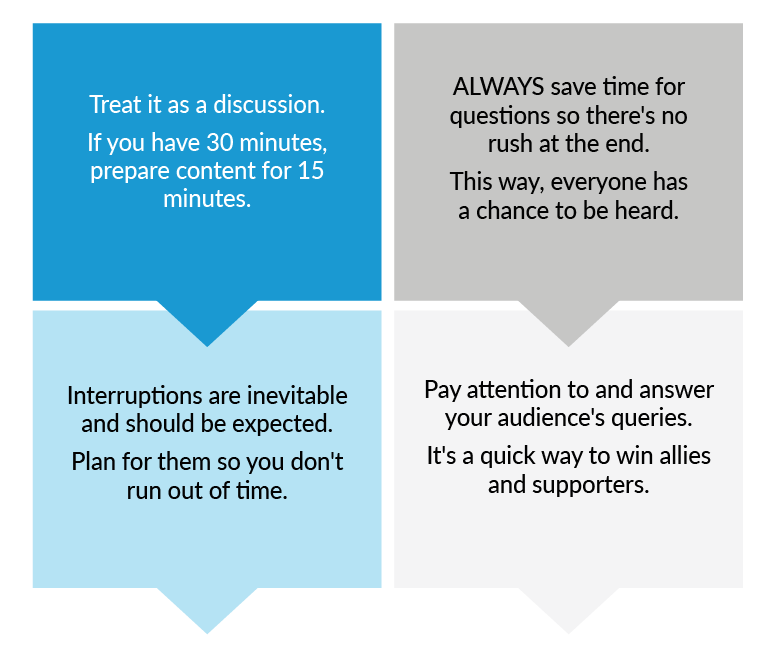
5. Be ready to zoom out
Be open to a discussion about topics related to but not limited to your presentation.
- Flexibility is key: Being able to 'zoom out' shows that you understand and can relate the specifics to the overall business strategy.
- Prepare for shifts: Have a clear understanding of how your detailed points connect to big-picture outcomes, ready to guide the discussion back to strategic implications whenever necessary.
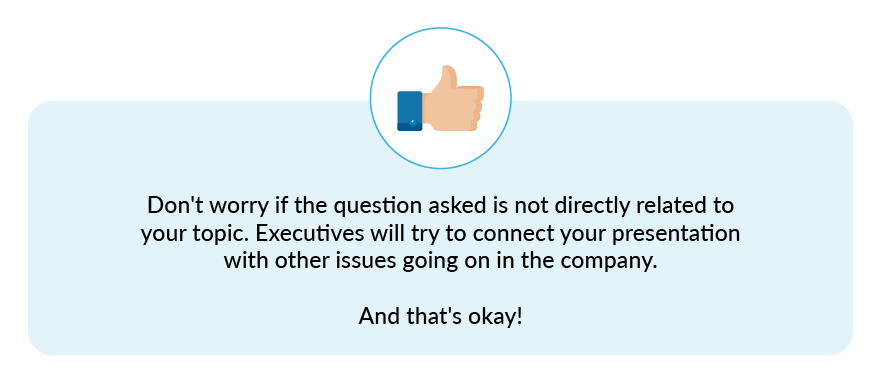
6. Customize executive summary for the project stage
To ensure that your executive summary resonates with senior leadership, it's effective to adapt it to the different stages of the problem-solving journey. Each stage has distinct communication needs that align with the objectives and progress of the project. Here are the stages:
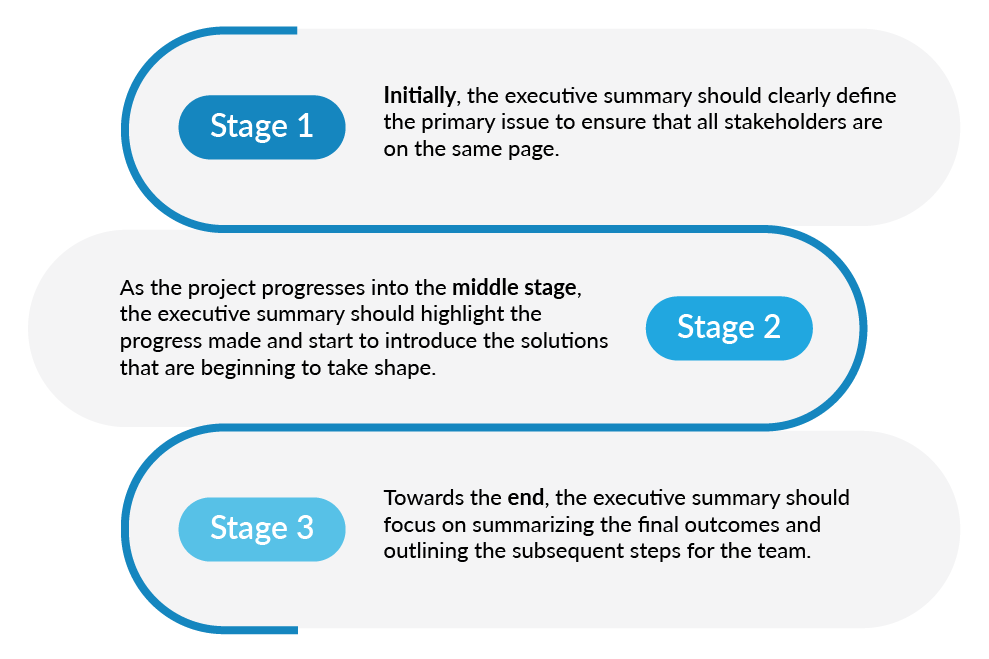
7. Start with the title and then build the slide
Design each slide by first deciding on a compelling title that encapsulates the slide’s message.
- Title as a guide: Treat each slide title as a newspaper headline—concise and informative. This strategy ensures that even a glance provides value, a technique found effective in high-level briefings.
- Consistency and focus: This method helps maintain a coherent narrative throughout the presentation, making it easier for executives to follow and retain the key points.


8. Channel nervous energy correctly to improve communication skills
Transform any presentation jitters into dynamic delivery.
- Harness Enthusiasm: Convert anxiety into enthusiasm. This transformation can significantly energize your presentation and make it more engaging. For example, imagine a speaker who starts their presentation with a slight tremble in their voice but uses that adrenaline to passionately emphasize the importance of their project, gradually speaking with more confidence and vigor. This shift can dramatically increase audience engagement.
- Stay Positive: A famous quote by Maya Angelou perfectly captures this: "People will forget what you said, people will forget what you did, but people will never forget how you made them feel." By maintaining a positive demeanor, you can leave a lasting impact on your audience, encouraging them to respond more openly and positively to your message.
9. Rehearse to impress and avoid jargon
Practice your presentation multiple times and keep the language clear and jargon-free.
- Confidence Through Preparation: Rehearsal builds confidence, ensures smoother delivery, and helps you manage time effectively.
- Clear Communication: Avoid technical terms that might confuse the audience, opting for simple language that articulates your points clearly and concisely.
10. Conclude strong
End with a powerful conclusion that reinforces your main messages and proposes clear next steps or calls to action.
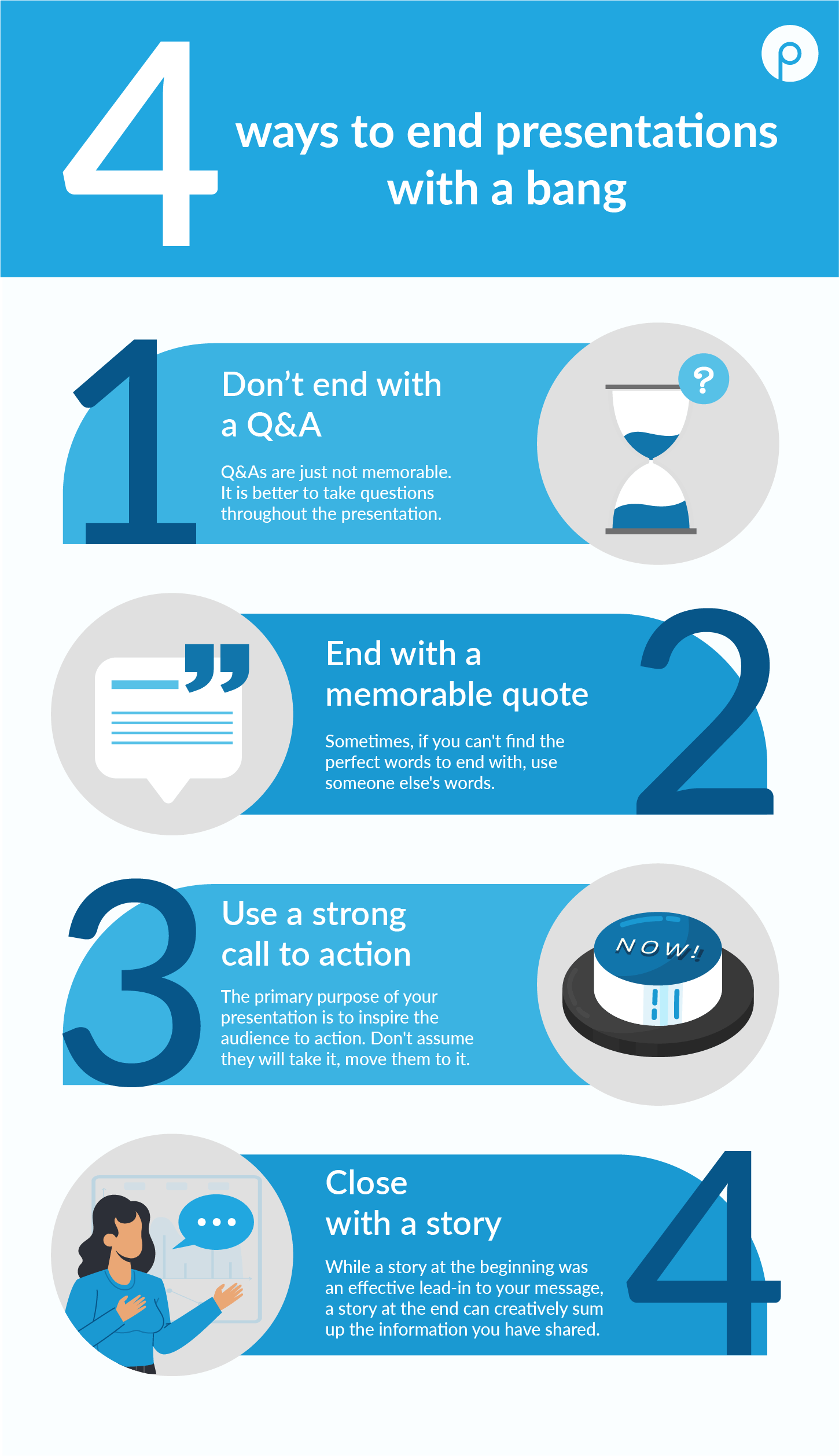
Summarizing key takeaways
• Presenting to senior executives is a high-stakes opportunity to influence decisions at the highest level of an organization.
• Understanding the challenges of executive presentations, such as time constraints, interruptions, pre-existing opinions, and high stakes, is essential for success.
• Implementing strategies like framing the topic quickly, setting expectations, using an inductive approach, and allocating time for discussion can enhance engagement and impact.
• Being flexible, adapting to executives' preferences, and customizing presentations for different project stages are crucial for resonance and effectiveness.
• Transforming nervous energy into dynamic delivery, staying positive, avoiding jargon, and concluding with a strong call to action can leave a lasting impression on senior leaders
FAQ's
1. Why are tips for presenting to senior executives crucial?
Tips for presenting to senior executives are crucial because these presentations are high-stakes opportunities that can influence the trajectory of your career and the bottom-line impact of your projects. Implementing effective presenting skills can accelerate your ability to make decisions and gain credibility within your organization.
2. What are some ways to improve my presentation skills when presenting to the executive team?
There are several ways to improve your presentation skills for high-stakes presentations. Firstly, it's essential to present data succinctly and clearly, focusing on the big picture and bottom-line impact. Additionally, practicing eye contact, gestures, and clarity in speech can enhance your ability to engage with execs and get your message across effectively.
3. How can I prepare for a nerve-wracking executive presentation ahead of time?
To prepare for a nerve-wracking executive presentation, proactively refine your presentation content and delivery through presentation training or coaching. Practice aloud, consider the pros and cons of your key points, and ensure your timeline is actionable and aligned with the audience's attention span. This preparation also shows confidence like a VP or executive would possess.
4. What should I do if I don’t expect to get cut short during my presentation?
Even if you don't expect to get cut short during your presentation, it's crucial to be succinct and get to the bottom line impact quickly. Executives are busy and may need concise information to make decisions. Be prepared to present data, answer questions, and encourage dialogue during the Q&A session to maintain engagement and credibility.
5. How can I ensure my presentation resonates with Fortune 500 companies or other high-level audiences?
To ensure your presentation resonates with Fortune 500 companies or other high-level audiences, tailor your content to address their specific needs and competitive advantages. Highlight actionable insights and solutions that align with their goals and trajectory. This approach not only demonstrates your brilliance but also shows that you understand their bottom-line impact and can provide value.
How can Prezent help you build impactful executive presentations?
Trusted by the Fortune 500, busy professionals are using Prezent to save time, cut costs, and elevate their communication skills. Here’s how:
- Understanding your audience with Communication Fingerprints: Prezent’s unique feature, Communication Fingerprints, allows you to tailor your presentation style and content to match the preferences and expectations of your specific audience. This tool analyzes audience characteristics to guide you in crafting messages that resonate more deeply with your listeners.
- Access a library of professional slides: No need to start from scratch. Prezent offers a comprehensive library of 35,000+ professionally designed slide templates that can be easily customized to fit your presentation needs. Whether you’re presenting financials, project updates, or strategic plans, you’ll find a template that sets the right tone.
- One-click executive summaries: Create concise, powerful executive summaries with just one click. Prezent’s smart technology helps you distill complex information into high-impact summaries that capture the essence of your message, making it easier for busy executives to grasp key points quickly.
- Uplevel communication skills with built-in curriculum: Improve your presentation skills with Prezent’s built-in curriculum. This 'Learn' feature provides practical tips and training to enhance your ability to communicate effectively, from structuring your message to delivering it with confidence.
By leveraging these capabilities, Prezent not only streamlines the presentation creation process but also ensures that the end result is professionally designed, aligned with your brand, and tailored to your audience's preferences. This comprehensive approach addresses common challenges faced in business communication, making it a powerful tool for anyone looking to elevate their presentation game.
Checkout all the above features and more with a 14-day free trial. Schedule a demo, speak to us to reserve 7 days extra free trial.



.avif)








